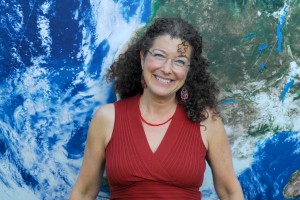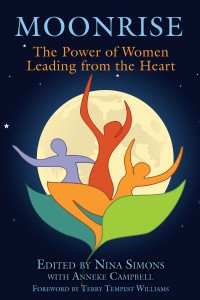Nina Simons is co-CEO and co-founder of Bioneers, a national nonprofit that identifies, gathers, and disseminates breakthrough solutions to environmental and social challenges. A speaker and teacher on the environment, restoring the sacred feminine, and the call to engaged action, she gives workshops on cultivating women’s leadership and co-produces the annual Bioneers Conference. She lives outside Santa Fe, New Mexico. What follows is a book excerpt from her new book, Moonrise, edited by Nina with Anneke Campbell.
To Walk in Beauty, by Sarah Crowell
I am the artistic director of a nonprofit arts education and violence
prevention organization called Destiny Arts Center, based in Oakland,
California. Our mission is to end isolation, prejudice, and violence in the
lives of young people. Every single day we just show up with our hearts as
open as possible. We teach violence prevention by serving youth ages
three to eighteen in after-school, weekend, and summer programs
featuring dance, martial arts, theater, self-defense, conflict resolution, and
leadership.
We’re located in a small community center in the middle of a residential
neighborhood. Here we intentionally limit the number of youth to 150, so
that we can remain true to our commitment to serve them at a deep level in
a place that feels like home. In order to serve larger numbers we send our
instructors out into twenty-five public preschool, elementary, middle, and
high schools each year. And our performance groups perform for up to
25,000 audience members annually.
It takes a whole lot of time, a whole lot of love, a whole lot of spirit and
patience for young people to recognize that they have the power to make
change. We, as their role models, have the responsibility to show them that
we understand our own power to make change so that they see it’s
possible.
I have to tell you a story. I did a theater exercise where I asked a group of
young people to get into a circle. It’s called the emotion game in which we
play with or create emotions in increasing intensity, from one to ten, ten
being huge. So the first emotion I gave them was fear. I said let’s
experience fear. I said, picture something that you’re really afraid of in the
middle of the circle. I counted from one to ten and by the time I got to ten
they were trembling and contorting their bodies in terror. It was palpable.
Then we did anger. Again, their bodies were really into it. One, two,
three . . . I slowly counted all the way to ten and their faces and bodies
were gripped and clenched in anger.
Then I said, okay, let’s try bliss. Who knows what that is? Somebody defined
it as extreme happiness. I said, that’s good enough. I started the
counting, one, two, three–and nothing happened. They just stood there
giggling, and telling me it was stupid. They couldn’t do it. I said: Okay, wait.
You mean to tell me that you can feel and express fear and anger but not
bliss? What are we here for then? Do you want to change the world? Start
right here. Experience bliss. I dare you.
I admit it, this was a dare to myself. I was praying at the same time. Lord,
they already think I’m crazy. And now I’m taking them to bliss? Then I
prayed, and I centered myself. I recognized that I had recently been in this
space of noticing how terrifying it is to want something and then ask and
expect to get it. It’s subtle, this releasing the fear of scarcity, which is a
story so safe it’s habitual. My task is to allow the fear to exist but to step
past it, and choose something different from fear in each interaction.
I want my students to be removed from the terror of wanting something
different, to know that they belong on the planet, that they belong in their
bodies, that they’re here as precious beings for a purpose, to connect with
other beings and to remove the illusion of separation between us all. I want
them to know that it requires incredible discipline and perseverance and
imagination to create change.
So here I was in a circle of teenagers daring them to experience, just for a
few moments, something other than the fear, anger, and disempowerment
they feel over and over again in their lives. I was asking them to be bold, to
be true revolutionaries. I said to them: Let us be willing to be in bliss,
because if we can’t do that, what are we creating? What are we dreaming
up for this world? It takes courage to be in this place of joy and bliss
together–maybe more than fear or anger. I could feel the group resonate
with what I was saying.
We all held hands and we looked at each other, and I asked: Are you with
me? Can you make the commitment to be in bliss with me right now?
Everybody was nodding. Their expressions were determined. So I counted,
one, two, three, four . . . Their bodies softened. Their expressions
sweetened. Their defenses dropped. By the time I got to ten, every single
kid in that circle was weeping with pure joy and amazement. They were
weeping because they saw each other’s beauty and felt their own.
Afterward, we sat and we debriefed. One girl, choking through her tears,
asked: If we could just see each other from this place all the time, who
would we be, what would this world be like?
What happens when we create this space for young people? What
happens when we witness and testify to their fear, anger, and
hopelessness and then model for them complete recognition that we can
also choose bliss, that we have the ability to see beauty in one another?
Giving them that opportunity lights up their hidden spaces and lets them
make bold strokes on life’s paper.
Sarah Crowell is the artistic director at Destiny Arts Center
(www.destinyarts.org), an arts education/violence prevention center for
youth based in Oakland, California. Sarah is the recipient of the 2007
KPFA peace award and the 2006 Purple Moon DreamSpeakers award.
She has performed both nationally and internationally with modern, jazz,
and dance/theater companies in Boston and the Bay Area since 1984.

